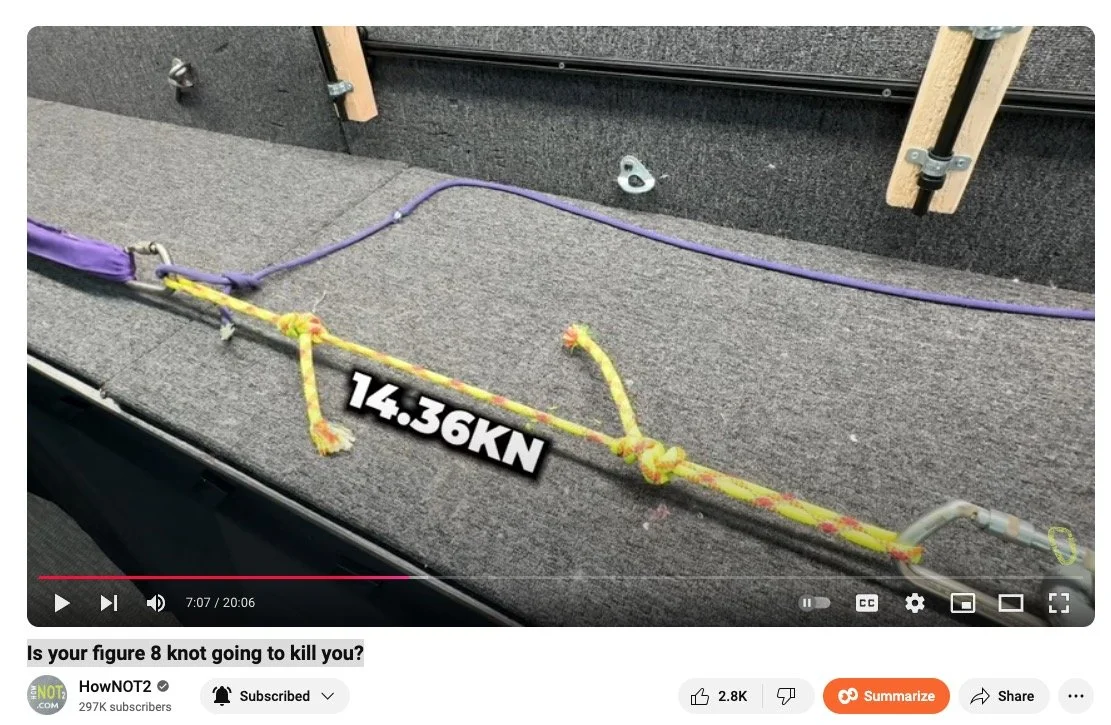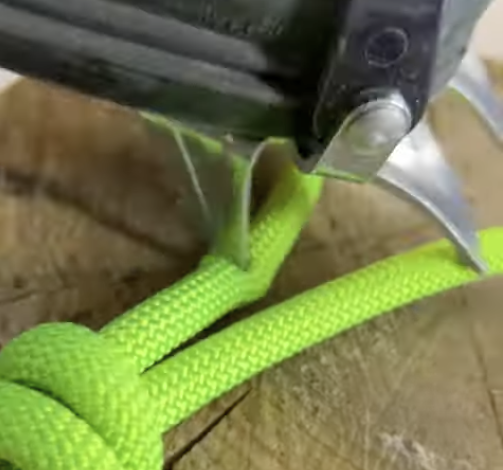
Alpine Tips
How strong is it? GEAR (Part 1)
Part of a continuing series of looking at strength of anchors, gear, and knots. How strong is a belay loop? How about a rope after you stomp on it with a crampon? Can I trust that rappel anchor made with old, sun bleached webbing? Learn the answers to these and more.
Premium Members can read the entire article here:
What's on this page?
How strong is a belay loop?
How strong is old, crusty, sun-bleached webbing?
How strong is your rope?
How strong is a rope after it’s been spiked by a crampon?
How strong is the core and sheath of a rope?
How strong is an HMS carabiner loaded on the gate side?
How strong is an edge loaded carabiner?
1 - How strong is a belay loop?
Between 20 and 30 kN
Source / testing: How NOT2, How do you know yours is safe?
We rely on this single, non-redundant point of a harness for almost everything, so it better be unquestionably strong!
UIAA ratings require a minimum strength of 15 kN. There can be wide variation depending on the age of your harness and the material, but you can count on 15 kN at a minimum.
HowNOT2 tested a bunch! The general range was between 20 and 30 kN.
(Yes, lots of Americans still remember the tragic Todd Skinner accident from 2006, where he died from a failure of his belay loop. I took a close look at that, and share some little-known details; you can read those here.)
2 -How strong is old, crusty, sun-bleached webbing?
As low as 3-ish kN, yikes!
Source / testing: HowNOT2 Youtube, “Would you rappel on this?
That tangle of rock-rat chewed, ancient rappel anchor? It can be as weak as 3-ish kN, which you can generate by bouncing a bit with just your bodyweight!
There have been at least two recent fatalities in the United States from failure of old webbing anchors. Carry some extra 6 mm cord, probably a knife, cut out old scary stuff like this and replace it with something better.
3 - How strong is your rope?
About 14 kN
Source / testing: HowNOT2, Is your figure 8 knot going to kill you?, about 7:05
Climbing ropes don’t have a strength rating like almost all your other gear, but I bet you're curious about it! Here's an approximate answer.
If you put a dynamic climbing rope that's around 9 mm around a cylindrical drum with enough friction so it doesn't have any knots, it will stretch a LOT, and break at around 20 kN.
But of course, that's not how you use a rope. A more realistic test is to take a short bit of rope, take a figure 8 on bight in each end, and break test that.
4 - How strong is a rope after it’s been spiked by a crampon?
About 11-ish kN - basically full strength!
Source / testing: HowNOT2 short video, “Crampon vs. Rope” (filmed with me at HowNOT2 world HQ in Seattle)
There you are, trudging along on a glacier climb with crampons, you're tired and getting a little bit sloppy and . . . OUCH, you step on your rope that's leading out to your partner in front of you. Is this a problem?
Fortunately, probably not. Although you might wanna mark the spot with some tape to inspect later, and consider retiring that rope.
I had a lot of fun filming this with Ryan. Because the single crampon spike did not yield dramatic results, Ryan got a little crazy with a hammer and a nail, putting multiple more spikes in the rope. Even after doing that, it was still close to full strength!
If you separate the core and sheath of a rope, how strong is each part?
If you clip four different things into a HMS masterpoint carabiner, does that weaken it?
If a carabiner is loaded across the edge of a rock, is that bad?
Join my Premium Membership to read the rest of the article.
Thanks for your support!
How strong is it? ANCHORS (Part 1)
So how strong is the girth hitch master point? How about if one strand gets cut? Can you girth hitch a sling to a carabiner (and survive?) Here's an overview of various flavors of anchor rigging, and links to actual break testing.
Premium Members can read the entire article here:
This section of my website is where I satisfy some of my curiosities (and hopefully some of yours) about the actual breaking strength of anchors, gear, and knots.
If you're new to this part of my website , I suggest you start at the overview page, and then bounce back here.
What's on this page?
What are the forces on the anchor when rappelling?
How strong is an overhand knot anchor in a nylon sling?
How strong is an overhand knot anchor in a Dyneema sling?
How strong is a girth hitch master point anchor with Dyneema?
How strong is a girth hitch master point anchor with Dyneema, if one strand gets cut?
How strong is a girth hitching a Dyneema sling to a carabiner?
How strong is a girth hitching a Dyneema sling to a bolt hanger?
1 - What are the forces on the anchor when rappelling?
If you bounce around on the rappel rope like a special forces cowboy, you can generate between 2 and 3 kN as a temporary peak load.
When you rappel smoothly, the load to the anchor is pretty much your body weight.
Source / testing: Youtube: What can go wrong when connecting two ropes? [dubbed]
Something we've all wondered when leaning back on a rappel anchor that’s Less Than Ideal . . . How strong does this thing really need to be? The gear experts at Edelrid did some testing, here's the answer.
Takeaway: rappel smoothly without bouncing to minimize force on the anchor.
2 - How strong is an overhand knot anchor in a nylon sling?
About 26 kN.
Source / testing: YouTube, You aren't supposed to tie a knot in this, Start around 15:50
One of the most common ways to make an anchor. Simple, easy to check, fast, redundant, and probably hard to untie.
3 - How strong is an overhand knot anchor in a Dyneema sling?
About 21 kN.
Source / testing: YouTube, You aren't supposed to tie a knot in this, Start around 11:00
While many people prefer to avoid tying knots in Dyneema, many folks think it's no problem. Again, this is a common and simple way to make an anchor.
Dyneema is less strong than nylon, but it's still #SuperGoodEnough for climbing. (Just don't expect to ever untie it . . .)
Takeaway:
If you double a sling like with the basket hitch, you get double the strength.
When you tie a knot in the doubled sling, you reduce the doubled strength by about half. So in the end, that leaves you with something close to the MBS for the original material.
We see this in both the nylon and Dyneema sling in the last two examples.
4 - How strong is a girth hitch master point anchor with Dyneema?
About 27 kN.
Source / testing: YouTube, Are climbing master points made with a girth hitch or clove hitch REDUNDANT??? Start around 7:00
The girth hitch master point is a modern standard for many climbers. Good to know it's super strong! And yes, it's redundant if one strand gets cut. Read my whole article on it here.
How strong is a girth hitch master point anchor with a cut strand?
How strong is a girth hitching a sling to a carabiner?
What about girth hitching a sling to a bolt hanger?!
Join my Premium Membership to read the rest of the article.
Thanks for your support!
How strong is it? OVERVIEW
We've all wondered - how strong is it? The Alpinesavvy web gnomes scoured the web to find some break testing for common (and not so common) gear, knots and rigging. Start here for an overview, and then head over to the more detailed articles.
Most climbing gear is tested and rated by Official Entities such as the CE and the UIAA. This is great! It gives us confidence that gear from brand-name manufacturers is made to the highest standards.
But not everything climbers use is covered by these ratings.
What about anchor rigging and knots?
What about rated gear that's old, a bit worn, a bit abused, but still hopefully serviceable?
What about gear that may be appropriate for climbing, but may not be officially rated by these agencies?
These are important questions.
My friend Ryan Jenks from HowNOT2.com has made an entire YouTube channel and brand based on breaking and testing climbing gear. (Give his YouTube a follow if you’re not already.)
The thing is, he's almost too successful. He's done so much testing that sometimes it's difficult to find the exact topic you’re interested in.
(To be fair, YouTube does a pretty good job of indexing his articles. If you go there and search for the term you want, you might find a video that covers it.)
So, I took some select tests (mostly from Ryan) and made a series of articles covering anchors, gear, and knots.
It's nowhere close to an exhaustive summary of all possible gear and rigging. It's more of a collection of Ryan's test results about which I was personally curious.
To keep things manageable, I have about 7 results on each article. As my curiosity continues (or I get submissions from Alpinesavvy fans like you) to add to this page, I will add part 2, part 3, etc…
I have links to sources and test results where appropriate.
If you have a new break test question / idea (and hopefully have a source for test results), please let me know about it and I might include it.
If you join Alpinesavvy as a Premium Member, you’re entered into monthly gear giveaways and regular discounts from Ryan’s store, hint hint.
Disclaimer: Yes, some of these test results are limited by the number of tests, to a specific manufacturer, they might be a static pull and maybe not drop tower, or vice versa, your mileage may vary, and blah-blah-blah. It's designed to give you a data point, not to apply universally to every situation. And as Ryan likes to say, this is entertainment, not science.
Basic premise #1 - What’s a kilonewton (kN?)
Let's start with the basics. A kilonewton is a metric unit of force, equal to the weight of about 100 kg or 225 pounds.
The way I like to think of it: one kN is the average weight of one NFL football player, more or less.
So, imagine this: A skinny 8 mm dynamic sling that's rated to 22 kN can hold about 22 football players all hanging off of it at the same time!
Yes, that is kind of crazy to think about! Yes, most all of the gear we use is impressively strong!
Fun facts . . .
the “N” is capitalized in “kN” because it refers to the last name of Sir Isaac Newton.
There are only three countries in the world that don’t use the metric system. Myanmar, Liberia, and ‘Merica. Metric measurements are the international standard of pretty much everything, especially climbing, and that's what this ‘Merican is using.
Basic premise #2 - What's the maximum force possible in recreational climbing?
About 9 kN.
Source: Engineer and climbing book author Craig Connally, from his book, The Mountaineering Handbook.
This is a somewhat challenging question to answer, but arguably the most important when it comes to talking about the strength of our gear and systems.
If the maximum possible force that you can ever create outside is around 9 kN, to me it seems kind of silly to argue about things like, “you shouldn’t girth hitch a Dyneema sling to a carabiner, it makes it weak!”, when it turns out it actually holds about 18 kN. (Which is stronger than your rope . . . )
A few things to keep in mind . . .
This maximum force can only happen in the very rare case of a factor 2 fall onto the anchor, which 99% of climbers will never experience.
There are various ways to avoid a factor 2 fall. Probably the best one is to place solid gear as soon after the anchor as possible on a multipitch climb.
This number will probably always remain somewhat theoretical, because you can't test factor 2 falls with a real humans, because they’ll get injured.
Testing in a drop tower with a concrete weight creates forces much higher than can happen in the real world . That's largely because of the squishy human body. Learn more about that here.
Here are some realistic scenarios involving real people, tested by Petzl and HowNOT2. Spoiler: Factor one fall, maximum force about 6 kN on the top piece of gear. Here's my article on that.


















